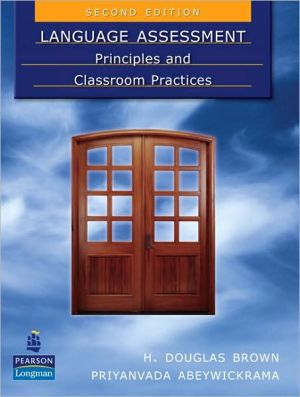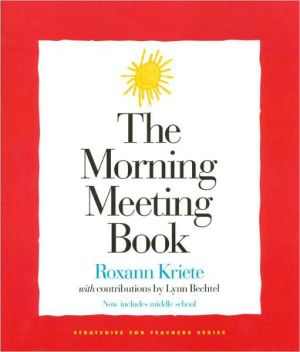Language Assessment: Principles and Classroom Practices
Language Assessment provides teachers with a clear presentation of the essentials for assessing second language learning fairly and effectively. This updated second edition includes new research and information on standardized tests, a new chapter on form-focused assessment, and a concise glossary of terms.\ With a focus on the most common pedagogical challenge – classroom-based assessment – Language Assessment delivers useful tools for evaluating and designing practical, effective assessment...
Search in google:
Language Assessment provides teachers with a clear presentation of the essentials for assessing second language learning fairly and effectively. This updated second edition includes new research and information on standardized tests, a new chapter on form-focused assessment, and a concise glossary of terms.With a focus on the most common pedagogical challenge – classroom-based assessment – Language Assessment delivers useful tools for evaluating and designing practical, effective assessment techniques.Features: Updated references and new information reflecting recent advances and current challenges in the field. Classification of assessment techniques ranging from controlled to open-ended item types on a specified continuum of micro- and macroskills of language. Systematic treatment of assessment for all four language skills (reading, writing, speaking, and listening) as well as grammar and vocabulary. Discussion of large-scale standardized tests, the ethics of testing, letter grading, and overall evaluation of student performance. Comprehensive presentation of alternatives in assessment, such as portfolios, journals, conferences, observations, interviews, and self- or peer-assessment. New Features Chapter objectives that preview content and goals A new chapter on form-focused assessment An appendix of commercially available tests A concise glossary of assessment terms
Chapter 1: Assessment Concepts and Issues Assessment and TestingMeasurement and EvaluationAssessment and LearningInformal and Formal AssessmentFormative and Summative AssessmentNorm-Referenced and Criterion-Referenced TestsTypes and Purposes of AssessmentAchievement TestsDiagnostic TestsPlacement TestsProficiency TestsAptitude TestsIssues in Language Assessment: Then and NowBehavioral Influences on Language TestingIntegrative ApproachesCommunicative Language TestingPerformance-based AssessmentCurrent “Hot Topics” in Classroom-based AssessmentMultiple IntelligencesTraditional and “Alternative” AssessmentComputer-based TestingOther Current IssuesExercisesFor Your Further ReadingChapter 2: Principles Of Language Assessment PracticalityReliabilityStudent-Related ReliabilityRater ReliabilityTest Administration ReliabilityTest ReliabilityValidityContent-Related EvidenceCriterion-Related EvidenceConstruct-Related EvidenceConsequential Validity (Impact)Face ValidityAuthenticityWashbackApplying Principles to the Evaluation of Classroom TestsExercisesFor Your Further Reading Chapter 3: Designing Classroom Language TestsFour Assessment ScenariosDetermining the Purpose of a TestDesigning Clear, Unambiguous ObjectivesDrawing Up Test SpecificationsDevising Test ItemsDesigning Multiple-Choice ItemsAdministering the TestScoring, Grading, and Giving FeedbackScoringGradingGiving FeedbackExercisesFor Your Further ReadingChapter 4: Standards-Based Assessment The Role of Standards in Standardized TestsStandards-Based EducationDesigning English Language StandardsStandards-Based AssessmentCASAS and SCANSTeacher StandardsThe Consequences of Standards-Based and Standardized TestingTest BiasTest-Driven Language and TeachingEthical Issues: Critical Language TestingExercisesFor Your Further Reading Chapter 5: Standardized Testing Advantages and Disadvantages of Standardized TestsDeveloping a Standardized TestStandardized Language Proficiency TestingExercisesFor Your Further Reading Chapter 6: Beyond Tests: Alternatives in Assessment The Dilemma of Maximizing Both Practicality and WashbackPerformance-Based AssessmentRubricsPortfoliosJournalsConferences and InterviewsObservationsSelf- and Peer-AssessmentsTypes of Self- and Peer-AssessmentGuidelines for Self- and peer-AssessmentA Taxonomy of Self- and Peer-Assessment TasksExercisesFor Your Further Reading Chapter 7: Assessing ListeningIntegration of Skills in Language AssessmentAssessing Grammar and VocabularyObserving the Performance of the Four SkillsThe Importance of ListeningBasic Types of ListeningMicro- and Macroskills of ListeningDesigning Assessment Tasks: Intensive ListeningRecognizing Phonological and Morphological ElementsParaphrase RecognitionDesigning Assessment Tasks: Responsive ListeningDesigning Assessment Tasks: Selective ListeningListening ClozeInformation TransferSentence RepetitionDesigning Assessment Tasks: Extensive ListeningDictationCommunicative Stimulus-Response TasksAuthentic Listening TasksExercisesFor Your Further Reading Chapter 8: Assessing SpeakingBasic Types of SpeakingMicro- and Macroskills of SpeakingDesigning Assessment Tasks: Imitative SpeakingVersant ®Designing Assessment Tasks: Intensive SpeakingDirected Response TasksRead-Aloud TasksSentence/Dialogue Completion Tasks and Oral QuestionnairesPicture-Cued TasksTranslation (of Limited Stretches of Discourse)Designing Assessment Tasks: Responsive SpeakingQuestion and AnswerGiving Instructions and DirectionsParaphrasingTest of Spoken English (TSE ®)Designing Assessment Tasks: Interactive SpeakingInterviewRole PlayDiscussions and ConversationsGamesACTFL Oral Proficiency Interview (OPI)Designing Assessments: Extensive SpeakingOral PresentationsPicture-Cued Story-TellingRetelling a Story, News EventTranslation (of Extended Prose)ExercisesFor Your Further ReadingChapter 9: Assessing ReadingGenres of ReadingMicroskills, Macroskills, and Strategies for ReadingTypes of ReadingDesigning Assessment Tasks: Perceptive ReadingReading AloudWritten ResponseMultiple-ChoicePicture-Cued ItemsDesigning Assessment Tasks: Selective ReadingMultiple Choice (for Form-Focused Criteria)Matching TasksEditing TasksPicture-Cued TasksGap-Filling TasksDesigning Assessment Tasks: Interactive ReadingCloze TasksImpromptu Reading Plus Comprehension QuestionsShort-Answer TasksEditing (Longer Texts)ScanningOrdering TasksInformation Transfer: Reading Charts, Maps, Graphs, DiagramsDesigning Assessment Tasks: Extensive ReadingSkimming TasksSummarizing and RespondingNote-Taking and OutliningExercisesFor Your Further Reading Chapter 10: Assessing WritingGenres of Written LanguageTypes of Writing PerformanceMicro- and Macroskills of WritingDesigning Assessment Tasks: Imitative WritingTasks in [Hand] Writing Letters, Words, and PunctuationSpelling Tasks and Detecting Phoneme-Grapheme CorrespondencesDesigning Assessment Tasks: Intensive (Controlled) WritingDictation and Dicto-CompGrammatical Transformation TasksPicture-Cued TasksVocabulary Assessment TasksOrdering TasksShort-Answer and Sentence Completion TasksIssues in Assessing Responsive and Extensive WritingDesigning Assessment Tasks: Responsive and Extensive WritingParaphrasingGuided Question and AnswerParagraph Construction TasksStrategic OptionsScoring Methods for Responsive and Extensive WritingHolistic ScoringPrimary Trait ScoringAnalytic ScoringBeyond Scoring: Responding to Extensive WritingAssessing Initial Stages of the Process of ComposingAssessing Later Stages of the Process of ComposingExercisesFor Your Further Reading Chapter 11: Assessing Grammar and Vocabulary Assessing GrammarDefining Grammatical KnowledgeDesigning Assessment Tasks: Selected ResponseMultiple-Choice (MC) TasksDiscrimination TasksNoticing Tasks or Consciousness Raising TasksDesigning Assessment Tasks: Limited ProductionGap-filling TasksShort Answer TasksDialogue Completion TasksDesigning Assessment Tasks: Extended ProductionInformation-gap TasksRole Play or Simulation TasksAssessing VocabularyThe Nature of VocabularyDefining Lexical KnowledgeSome Considerations in Designing Assessment TasksDesigning Assessment Tasks: Receptive VocabularyDesigning Assessment Tasks: Productive VocabularyExercisesFor Your Further Reading Chapter 12: Grading and Student EvaluationPhilosophy of Grading: What Should Grades Reflect?Guidelines for Selecting Grading CriteriaMethods for Calculating GradesTeachers’ Perceptions of Appropriate Grade DistributionsInstitutional Expectations and ConstraintsCross-Cultural Factors and the Question of DifficultyWhat Do Letter Grades “Mean”?Calculating GradesAlternatives to Letter GradingSome Principles and Guidelines for Grading and EvaluationExercisesFor Your Further ReadingAppendix: Commercial TestsGlossaryBibliographyName IndexSubject Index








